
Wrightsville Beach anglers can find hard-fighting gamefish during March at the Liberty Ship.
Only a few empty trailers were parked at the parking lot at the Wrightsville Beach Wildlife ramp last March.
The trailers created a question — was the early run of bonito Capt. Matt Wirt (Reel Adventure Charters, 910-540-0570, www.reel-adventure.com) had found a few days earlier a freak occurrence or had the fish arrived and word hadn’t spread?
It was just before daylight, and even with the limited number of parking spaces designated for vehicles without trailers, only one was taken. In the pre-dawn chill, the question remained. But the wind was flat calm, and there was nothing to do but head out and see for ourselves.
The timing was impeccable as Wirt eased his Sea Chaser bay boat into the water. The great weather and lack of crowd at the ramp boosted his spirits. The pre-dawn glow lighted his broad smile.
“We’re gonna get ’em this morning,” he said. “I’ve heard people talking about (bonito) since the other afternoon and figured we’d be crowded or the weather crappy, but this looks great. It’ll be a bit chilly on the way out, but we’ll be sweating soon enough.”
Wirt had stumbled upon the season’s first school of bonito a few days earlier, but it took a couple of days to get schedules to mesh before making another trip. This morning it appeared the wait had been worthwhile. The weather and seas were perfect — now if the guests of honor would just put in an appearance.
Sliding across the mirror-calm water, Wirt eased the throttle forward of his reliable, quiet Suzuki four-stroke and said while we might encounter a school of bonito anywhere outside Masonboro Inlet, we were headed for the Liberty Ship, also known as AR 370 or the Meares Harris Reef. If bonito were scarce at the Liberty Ship, Plan B would be to head for AR 372 (aka the 5-Mile Boxcars).
As we motored offshore, we looked for schools of feeding fish, revealed by flocks of birds hovering above or diving on baitfish.
Approaching the Liberty Ship, it was evident a few boats already were working in the area. But the real action hadn’t started. Just as the sun cleared the eastern horizon, a small school of fish erupted at a school of baitfish at the other side of the reef. Several boats immediately headed for commotion, but Wirt wasn’t tempted to move.
“With those boats running at them, that school will dive before we can get there,” he said. “When they dive, they’ll come up somewhere else. If we aren’t making any commotion, it might just be here.”
Wirt proved to be prophetic; the small school of gamefish submerged as the boats converged, then, after a couple of minutes, they resurfaced just out of casting range to our left.
“Those are bonito,” Wirt said, turning toward the school. “When these guys run at them again, they’ll probably dive so as soon as you can reach them, cast and retrieve quickly.”
Trevor Smith, holding one of Wirt’s custom-built Next Level Rods, rocketed a medium-size Maria jig into the fracas, closed the bail and reeled quickly Before Wirt could move closer, Smith’s reel began to sing.
A feisty bonito zipped about 50 yards of line off the spinning reel’s spool before slowing and turning. The fight paused momentarily, but this fish wasn’t quite ready to surrender. After a couple of seconds, the bonito took line again but it was a little tired and the pressure of the drag caused it to run more of a circle than a straight line; it didn’t take any more line.
When the fish paused again, Smith pumped his rod and spun the handle on the downstroke to gain line on the diminutive tuna. After another short run, Smith began bringing the fish toward the boat.
The little fish fought well, just like a tuna. However, it was a 4-pound bonito, not a 40-pound yellowfin or 400-pound bluefin. Within a few minutes, Wirt cradled the beautiful, striped fish in his landing net.
“Somebody will have some fine eating tonight,” Wirt said. “I’ve got some (bonito) left from the other day, so do one of you guys want it? If not, I’m going to let it go.”
After waiting 5 seconds (a respectable amount of time for Smith to replay), I volunteered to take the bonito, destined for a later date that evening with sushi rice, soy sauce and wasabi.
“Let’s catch some more,” Wirt said. “These are nice fish, and we don’t often find them with a crowd (of other anglers) this small. Besides, I know it doesn’t seem possible this early, but I thought I saw a Spanish (mackerel) in that last group.”
As the sun rose in the clear morning sky, schools of bonito began to attack baitfish on the surface. At least one group ravaged prey every minute and many times several schools of bonito were active, along with some early Spanish mackerel. Two Spanish came to the landing nets, but no one caught a false albacore that morning.
False albacore are a cousin of bonito, and the two often are misidentified by anglers. Anglers often believe false albacore are bonito, but they’re different species. Bonito should be offended at the mistake.
Both are members of the tuna family and are roughly similar in their football body shape, but their markings are different. Bonito have vertical stripes marking their upper flanks and sport sharp teeth. False albacore have a single chain-like stripe underneath the dorsal fin and don’t have noticeable teeth.
Atlantic bonito and false albacore also have vastly different tastes to the human palate. Bonito flesh is mild, tasty and can be prepared in a variety of ways, including as sashimi for serving with sushi rice. False albacore have blood-red meat that tends to be too strong for anyone except those who relish really robust fish.
By mid-morning we’d become fairly proficient at catching bonito. Wirt used two techniques, motoring us upwind to drift near a school for casts or quickly darted within casting range of aggressively feeding fish.
Once within range, we cast jigs into the melee, reeled quickly and tried to be prepared for aggressive strikes. We fought lots of fish and even managed to hook up with doubles a few times. The key seemed to be to cast just beyond and in front of moving fish, then retrieve the jig quickly. That’s when the strikes came fast and furious.
Action was continuous during this calm, sunny morning until about 10:30 a.m. when the bite ceased abruptly. Suddenly no anglers were hooked up with bonito, no fish jumped, and the birds had disappeared. Since the action had been so frantic to this point for our boat and anglers in nearby boats, everyone was puzzled.
Someone said an off-switch had been flipped. Then, just as quickly, the switch was flipped back to the on-position.
But the tuna exploding now weren’t the same fish we’d caught previously. The water above AR 370 suddenly erupted into a combat zone of ravenously feeding juvenile bluefin tuna.
It seems strange to describe a fish weighing 75 to 150 pounds as a “juvenile,” but the area had become alive with baby bluefins devouring everything in sight.
If the sight of a 150-pound bluefin, half out of the water, with mouth open and only inches behind a healthy bonito won’t get an angler’s pulse racing, nothing will.
The 3-to 5-pound bonito and 2- to 4-pound Spanish mackerel anglers had caught earlier in the day had become the hunted, not the hunters. And they were scattering wildly, trying not to become the main course for a ravenous pack of marauding baby bluefins.
Once, a bluefin torpedoed so near Wirt’s boat everyone waited for the thump when he hit. The tuna missed the boat, but the bonito he chased wasn’t quite as fortunate. Obviously humans aren’t the only ones who appreciate a meal of fresh bonito.
The carnage captivated the boating anglers for a few minutes until the sea became calm again. An eerie calm settled near AR 370 and, with amazement and adrenaline in his voice, Wirt assessed the situation with amazing understatement.
“Wow,” he said. “I bet not many people get to see something like that. And I’ll bet our fishing is over for a while here.
“It’s been a good morning, and we got to see that little display of bluefin appetite and power.
“That was awesome. Why don’t we head in, clean these fish and call it an early day?”


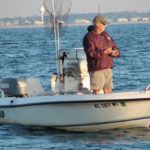
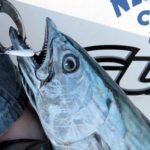
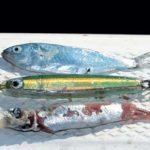
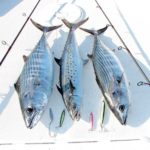
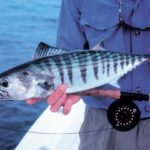



Be the first to comment